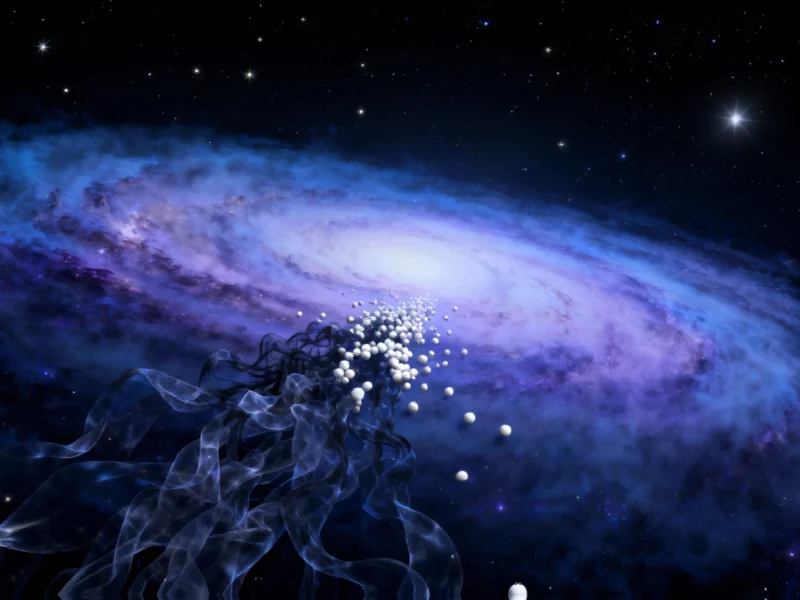In a cosmic detective story spanning decades, astrophysicists are closing in on one of the universe’s greatest mysteries: the true nature of dark matter. New research from Johns Hopkins University suggests that a persistent gamma-ray glow at the Milky Way’s core could finally provide the breakthrough scientists have been seeking—or deepen the mystery further.
The findings, which reveal equally compelling cases for both dark matter collisions and neutron star activity, represent a significant advancement in our understanding of galactic phenomena. “We’re at a critical point where multiple explanations fit the data equally well,” explained Professor Joseph Silk, co-author of the study. “This paradox pushes us toward more sophisticated detection methods.”
The Galactic Center Conundrum
For over a decade, astronomers have puzzled over an unexplained gamma-ray emission emanating from the heart of our galaxy. This diffuse glow has resisted conventional explanation, presenting researchers with two equally plausible scenarios. The first involves collisions between hypothetical dark matter particles, while the second points to rapidly rotating neutron stars known as millisecond pulsars.
What makes this research particularly compelling is the methodology. The team employed supercomputers to create the most detailed maps yet of dark matter distribution within the Milky Way, accounting for the galaxy’s formation history for the first time. Their simulations revealed that during the galaxy’s early development, numerous smaller systems rich in dark matter merged into the young Milky Way, concentrating dark matter toward the center and increasing collision probabilities.
Matching Cosmic Patterns
The breakthrough came when researchers incorporated more realistic collision models into their simulations. The resulting gamma-ray maps showed remarkable alignment with actual observations from NASA’s Fermi Gamma-ray Space Telescope. This correlation completes a triad of evidence supporting the dark matter hypothesis, though researchers remain cautious about declaring victory.
“The match between our simulations and actual observations is striking,” noted Silk. “However, in science, correlation doesn’t always mean causation. We must consider all possibilities with equal rigor.” This balanced approach reflects the growing emphasis on comprehensive data analysis across scientific disciplines, where multiple hypotheses are tested simultaneously.
The Pulsar Alternative
The competing explanation—that millisecond pulsars generate the gamma-ray excess—presents its own compelling case. These rejuvenated neutron stars, spinning hundreds of times per second, could theoretically produce the observed radiation pattern. However, this theory requires assuming the existence of many more pulsars than astronomers have currently detected.
This scientific standoff highlights the challenges of cosmic observation, where technological limitations often shape our understanding of complex systems. The pulsar hypothesis, while mathematically viable, stretches current observational capabilities to their limits.
The Path Forward
Resolution may come with the construction of the Cherenkov Telescope Array, a next-generation gamma-ray observatory capable of measuring high-energy signals with unprecedented precision. The research team is planning experiments to determine whether the Milky Way’s gamma rays exhibit the higher energy signature characteristic of pulsars or the lower-energy profile expected from dark matter collisions.
Simultaneously, researchers will test their predictions against observations of dwarf galaxies orbiting the Milky Way. These satellite galaxies, believed to be dark matter-rich environments, could provide the controlled conditions needed to distinguish between competing theories.
The implications extend beyond astrophysics, touching on broader questions about how we measure and understand complex systems across different fields. As Silk concluded: “Whatever we discover—whether it confirms one theory, the other, or neither—will fundamentally advance our understanding of the universe’s hidden architecture.”
The coming years promise to be transformative for dark matter research, as improved observational capabilities and sophisticated modeling techniques bring scientists closer than ever to solving one of cosmology’s most enduring mysteries.
Based on reporting by {‘uri’: ‘innovationnewsnetwork.com’, ‘dataType’: ‘news’, ‘title’: ‘Innovation News Network’, ‘description’: ”, ‘location’: None, ‘ranking’: {‘importanceRank’: 1000000}}. This article aggregates information from publicly available sources. All trademarks and copyrights belong to their respective owners.



